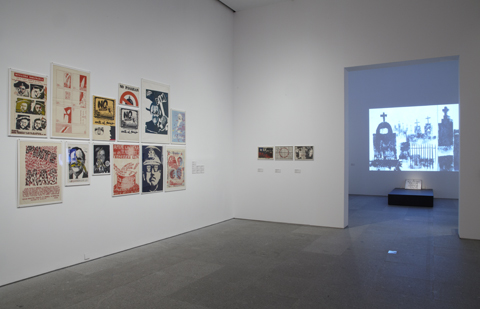Museo Nacional de Arte Reina Sofia,
Oct 26, 2012 - Mar 11, 2013
Madrid, Spain
Losing the human form. A seismic image of the 1980s in Latin America
by Francisco Godoy
I don’t turn the other cheek; I take it up the ass partner
The exhibition’s second thematic axis deals with sexual disobediences, in the possible crossroads between sexed bodies and political repression. In my opinion this is the exhibition’s most intense and consistent section. One could say it is presented in two spaces: the first space dovetails with the previous theme by providing access from the Yeguas del Apocalypses’ performance. The audio of Perlongher’s powerful poem cadavers (corpses) floods the three rooms that make up this axis, where the sound works as a link between a "territory of violence" featuring works by the theater collective El Periférico de Objetos, Osvaldo Salerno and Alejandro Montoya, and a "territory of freedom" featuring performance documentation by Sergio Zevallos and the Compañía Argentina de Mimo. Additionally, there are spaces containing works by Mónica Mayer, No-grupo and Polvo de Gallina Negra from Mexico, and interventions by Eduardo Kac, 3Nós3 and others, from Brazil.
The second space, painted gray to break away from the "visibility" of the other sections, features the only "oil on canvas" in the show –Juan Dávila’s El arte es homosexual (Art is Homosexual) — along with performance documentation and artworks by Carlos Leppe, Miguel Ángel Rojas, Paz Errázuriz, Sergio Zevallos and Liliana Maresca. There is no doubt that it is one of the most effective spaces in the show. It connects with the final baroque-like labyrinth within the exhibition featuring countless documents, videos and audio tracks of punk and underground scenes as spaces that regrouped dissident subjectivities. These excesses are counterproductive as understanding its relevance to the show is made more difficult. This is also the case with another labyrinth within the exhibition, created to show, through the use of a tunnel, some offshoots of experimental theatre and music and their articulation with surrealism and Trotskyism in groups from Argentina and Brazil under the slogan ¡demoler las paredes alrededor de las ventanas (Demolish the walls around the windows!)
Can’t be catalogued
There are other gaps in the exhibition that are not directly related to the three axes mentioned above. They include works that, through reproduction, intervention in the media and performance, give an account of "absences". León Ferrari’s archive of newspaper clippings Nosotros no sabíamos (We Didn’t Know), Guillermo Deisler’s etchings, Clemente Padín’s performances and Alvaro Barrios’s distributable pop etching El martirio de San Sebastián (Saint Sebastian’s Martyrdom) are examples of works that either dialogue with "documents" like Teleanálisis, a clandestine Chilean news bulletin distributed in VHS format, or directly with the exhibition’s interpretative space. This is set up in such a way that fanzines and magazines are combined with virtual documents and viewers can access various materials pertaining to the projects at the end of the show. This is also where the only reference to Cuba appears in the entire show.
Apart from Salerno, the "Paraguayan presence" focuses on a series of masks of the Arete Guasú ritual recovered and put to use by Ticio Escobar in the 80s and presented in two formats. On one side, a series of masks appear like ghosts either suspended from above or in display cabinets, which detracts from the different narratives of the exhibition spaces. On the other, they are concentrated in another room that seems to have little bearing on the activist approach of the rest of the show. Although this room could be said to call attention to "the indigenous problem", a theme that in general is not addressed by the other works, their appearance throughout the exhibition seems rather anecdotal and lacking in context.
In addition to an inaugural seminar, the exhibition features a selection of weekly film and video screenings at the museum, entitled El roce de los cuerpos (The Rubbing of Bodies). These works give the impression of being those aforementioned corpses rescued from their tombs, although many would have taken on a new lease of "life" within the exhibition.
|









